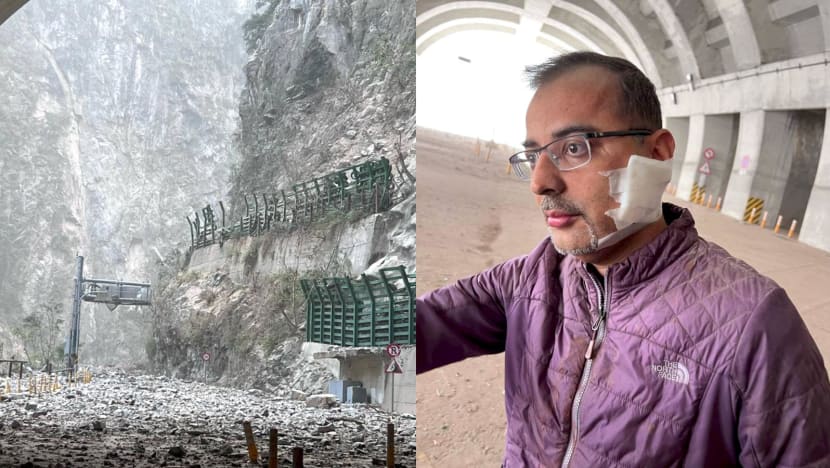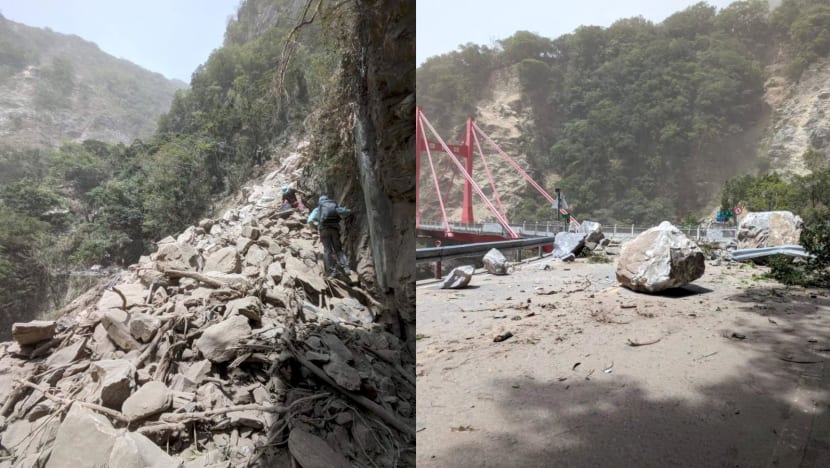'We lived to tell a story': Couple trapped in tunnel for 24 hours after Taiwan earthquake
Ms Namrata Kohli and her husband were walking along a trail at Taroko National Park in Hualien when they felt the ground shake.

Left: Ms Namrata Kohli and her husband on a hike at Taroko National Park before the earthquake struck. Right: Survivors walking to safety in the aftermath of the earthquake. (Photos: Namrata Kohli)

This audio is generated by an AI tool.
SINGAPORE: When Ms Namrata Kohli heard that a Singaporean couple was missing at Taroko National Park amid a 7.4-magnitude earthquake in Taiwan, her first thought was that it could have easily been her and her husband.
“It could have been us, I don’t know how it wasn’t us,” said the 39-year-old Employment Pass holder who has worked in Singapore for over six years at tech firm Meta.
“I still hope and pray that they are brought out safely.”
The news of the missing couple shook Ms Namrata as she and her husband were stuck in a tunnel at the same national park for 24 hours, caught in the middle of Taiwan’s worst earthquake in 25 years last Wednesday (Apr 3).
The couple had travelled to Taiwan on Mar 29 for what was supposed to be a 12-day trip. They visited the Shakadang Trail at the national park the day before the earthquake, which was where the Singaporean couple was last seen.
On the day of the quake, Ms Namrata and her husband had driven from Hualien City to the Tunnel of Nine Turns at the park, to hike another trail there.
They parked the car at the tunnel and set off on the short trail through the mountainous terrain. It was on the way back from the trail, at about 8am, that the ground started to shake.
“As the vibration started to gain momentum both of us just ran,” she said. “We both started to run as fast as we could, but then the rocks started to fall as well.”
One of the rocks hit her husband in the face, injuring his ear and cheek. They sought shelter in a small cave-like structure as rocks fell around them, and she could feel small rocks pelt her ankles and knees.
When the tremors subsided, they saw they were almost at the end of the trail, and so walked about 100m to their car parked in the tunnel.
Shaken but safely in the car, they assumed the next step would be to drive out of the national park and back to Hualien City, but they could not have been more wrong.

TRAPPED IN A TUNNEL FOR 24 HOURS
Ms Namrata and her husband soon realised they were trapped in the tunnel. One end of the tunnel was still being pelted by a “drizzle” of rocks falling off the adjacent cliffs.
On the other side was pitch darkness, with air dense with dust and particles stirred up from the quake.
“We obviously realised we couldn't drive anywhere from here (so) we just sort of waited … I thought it was (just) the two of us,” she said.
But a few minutes later, some people walked towards them, who turned out to be staff at a hotel down the road. While they did not speak each other’s language, they managed to communicate sufficiently.
“I think locals there are taught from a young age what to do when an earthquake strikes. (They said) the tunnel is the safest place to be,” she said. “So they told us don't go anywhere … most likely, we were going to be there for some time.”
As the hours passed, more stranded hikers began to walk into the tunnel to seek refuge from the aftershocks and continued rockfall. All in all, there were 18 people in the tunnel as day turned into night.
Soon, hunger and thirst began to set in — most of them only brought enough food for a hike, and these included snacks like granola bars and a bottle of water.
Thankfully, there was a small guard room at the entrance of the tunnel, which had a first aid kit and even a stove. A security guard who was stationed there cooked the trapped hikers some noodles and soup which they shared around.
Those trapped also shared water, food and painkillers with each other. They also helped administer first aid to Ms Namrata’s husband for the wound on his cheek.
“The people of Taiwan … they’re the most calm, kind, considerate people ever … It was just humanity at its best coming together in that moment,” she said.
STARVE OR RISK BEING HIT BY ROCKS
As morning came the next day, there was still no sign of any rescuers. This did not come as a surprise as aftershocks were happening about every 30 mins.
“Every time it shook … rocks would fall, debris would fall, so it was very unsafe to get out,” said Ms Namrata.
While they would have preferred to stay in the tunnel until rescuers came, they knew that their rations of food and water would run out eventually.
And so the couple and other trapped hikers had a decision to make: Starve or risk being injured or killed by rocks while finding a way out.
And so, at about 6.30am, Ms Namrata and her husband were among a group of 10 who decided to walk out into the open to find a way to a hotel deeper in the park, which was 7km down the road.
This was an “incredibly dangerous” walk, said Ms Namrata, with the constant risk of rockfall and landslides.
“There were multiple times in that journey when I thought I wouldn't make it,” she said. “There is a fairly high chance that you either get hit by a small stone or pretty much get buried alive if a big rock comes down.”
She added that the roads were completely destroyed, and the rubble had formed large mounds in some areas the trapped hikers had to climb over. At areas that they felt were prone to landslides, the hikers ran.
By a stroke of luck, the group managed to make it to the hotel in under two hours.

GRATEFUL TO BE ALIVE
At the hotel, Ms Namrata was finally able to call her parents in India on a satellite phone to tell them she was safe. It was a tearful call as her parents had not heard from her for 24 hours at that point.
The survivors were able to get some food at the hotel, as well as get cleaned up. Guests at the hotel even offered to give their clothes to the survivors so they had something fresh to change into.
A hotel guest who happened to be a doctor saw the condition of Ms Namrata’s husband and ascertained it to be serious enough for him to be airlifted back to the city for urgent medical care.
“If he didn't get stitched up in time, he might lose his earlobe,” she said.
And so on that day, Ms Namrata and her husband were airlifted back to Hualien, where her husband received eight stitches to close his wound.
The couple flew back to Singapore on Apr 5 – cutting their trip short by five days – and Ms Namrata said she is physically safe but still traumatised.
She is seeking “professional help” to address the trauma, but said that speaking about it publicly is one way for her to try to move on.
“I feel like I lived to tell a story … I feel an immense sense of gratitude; so much could have gone wrong, and we still made it out alive.”
She added that the “small things” she used to complain about are now things that she is grateful to be able to experience now, having had such a close shave with death.
“I no longer complain that it's hot in Singapore, I don't complain that my husband snores … My husband snoring at night is one of the best sounds in the world right now,” she said.
“We have one life, we owe it to ourselves and the people around us to make the most of what we have.”















